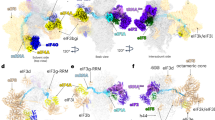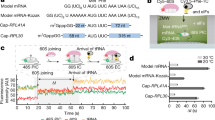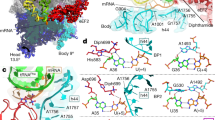Abstract
The scanning model of translation initiation is a coherent description of how eukaryotic ribosomes reach the initiation codon after being recruited to the capped 5′ end of messenger RNA. Five eukaryotic initiation factors (eIF 2, 3, 4A, 4B and 4F) with established functions have been assumed to be sufficient to mediate this process. Here we report that eIF1 and eIF1A are also both essential for translation initiation. In their absence, 43S ribosomal preinitiation complexes incubated with ATP, eIF4A, eIF4B and eIF4F bind exclusively to the cap-proximal region but are unable to reach the initiation codon. Individually, eIF1A enhances formation of this cap-proximal complex, and eIF1 weakly promotes formation of a 48S ribosomal complex at the initiation codon. These proteins act synergistically to mediate assembly of ribosomal initiation complexes at the initiation codon and dissociate aberrant complexes from the mRNA.
This is a preview of subscription content, access via your institution
Access options
Subscribe to this journal
Receive 51 print issues and online access
$199.00 per year
only $3.90 per issue
Buy this article
- Purchase on Springer Link
- Instant access to full article PDF
Prices may be subject to local taxes which are calculated during checkout





Similar content being viewed by others
References
Kozak, M. How do eukaryotic ribosomes select initiation regions in messenger RNA? Cell 15, 1109–1123 (1978).
Kozak, M. The scanning model for translation: An update. J. Cell. Biol. 108, 229–241 (1989).
Merrick, W. C. & Hershey, J. W. B. in Translational Control (eds Hershey, J. W. B., Mathews, M. B. & Sonenberg, N.) 31–70 (Cold Spring Harbor Laboratory Press, NY, (1996)).
Pestova, T. V., Hellen, C. U. T. & Shatsky, I. N. Canonical eukaryotic initiation factors determine initiation of translation by internal ribosomal entry. Mol. Cell. Biol. 16, 6859–6869 (1996).
Pestova, T. V., Shatsky, I. N. & Hellen, C. U. T. Functional dissection of eukaryotic initiation factor 4F: the 4A subunit and the central domain of the 4G subunit are sufficient to mediate internal entry of 43S preinitiation complexes. Mol. Cell. Biol. 16, 6870–6878 (1996).
Pestova, T. V., Shatsky, I. N., Fletcher, S. P., Jackson, R. J. & Hellen, C. U. T. Aprokaryotic-like mode of binding of cytoplasmic eukaryotic ribosomes to the initiation codon during internal initiation of translation of Hepatitis C and Classical Swine fever virus RNAs. Genes Dev. 12, 67–83 (1998).
Anthony, D. D. & Merrick, W. C. Analysis of 40S and 80S complexes with mRNA as measured by sucrose density gradients and primer extension inhibition. J. Biol. Chem. 267, 1554–1562 (1992).
Dever, T. E. et al. Determination of the amino acid sequence of rabbit, human, and wheat germ protein synthesis factor eIF-4C by cloning and chemical sequencing. J. Biol. Chem. 269, 3212–3218 (1994).
Fields, C. & Adams, M. D. Expressed sequence tags identify a human isolog of the sui1 translation initiation factor. Biochem. Biophys. Res. Commun. 198, 288–291 (1994).
Kasperaitis, M. A. M., Voorma, H. O. & Thomas, A. A. M. The partial amino acid sequence of eukaryotic translation initiation factor 1 and its similarity to yeast initiation factor sui1. FEBS Lett. 365, 47–50 (1995).
Kaminski, A., Howell, M. T. & Jackson, R. J. Initiation of encephalomyocarditis virus RNA translation: the authentic initiation site is not selected by a scanning mechanism. EMBO J. 9, 3753–3759 (1990).
Kemper, W. M., Berry, K. W. & Merrick, W. C. Purification and properties of rabbit reticulocyte protein synthesis initiation factors M2Bα and M2Bβ. J. Biol. Chem. 251, 5551–5557 (1976).
Schreier, M. H., Erni, B. & Staehelin, T. Initiation of mammalian protein synthesis. I. Purification and characterization of seven initiation factors. J. Mol. Biol. 116, 727–753 (1977).
Trachsel, H., Erni, B., Schreier, M. H. & Staehelin, T. Initiation of mammalian protein synthesis. II. The assembly of the initiation complex with purified initiation factors. J. Mol. Biol. 116, 755–767 (1977).
Benne, R. & Hershey, J. W. B. The mechanism of action of protein synthesis initiation factors from rabbit reticulocytes. J. Biol. Chem. 253, 3078–3087 (1978).
Thomas, A., Goumans, H., Voorma, H. O. & Benne, R. The mechanism of action of eukaryotic initiation factor 4C in protein synthesis. Eur. J. Biochem. 107, 39–45 (1980).
Thomas, A., Spaan, W., van Steeg, H., Voorma, H. O. & Benne, R. Mode of action of protein synthesis initiation factor eIF-1 from rabbit reticulocytes. FEBS Lett. 116, 67–71 (1980).
Chaudhuri, J., Si, K. & Maitra, U. Function of eukaryotic translation initiation factor 1A (eIF1) (formerly called eIF-4C) in initiation of protein synthesis. J. Biol. Chem. 272, 7883–7891 (1997).
Yoon, H. & Donahue, T. F. The sui1 suppressor locus in Saccharomyces cerevisiae encodes a translation factor that functions during tRNAMeti recognition of the start codon. Mol. Cell. Biol. 12, 248–260 (1992).
Wei, C.-L., MacMillan, S. E. & Hershey, J. W. B. Characterization of yeast translation initiation factor 1A and cloning of its essential gene. J. Biol. Chem. 270, 5764–5771 (1995).
Wei, C.- & perio, C.- Kainuma, M. & Hershey, J. W. B. Protein synthesis initiation factor eIF-1A is a moderately abundant RNA-binding protein. J. Biol. Chem. 270, 22788–22794 (1995).
Chen, C.-Y. & Sarnow, P. Initiation of protein synthesis by the eukaryotic translation apparatus on circular RNAs. Science 268, 415–417 (1995).
Jackson, R. J. in Translational Control (eds Hershey, J. W. B., Mathews, M. B. & Sonenberg, N.) 71–112 (Cold Spring Harbor Laboratory Press, NY, (1996)).
Cui, Y., Dinman, J. D., Kinzy, T. G. & Peltz, S. W. The Mof2/Sui1 protein is a general monitor of translational accuracy. Mol. Cell. Biol. 18, 1506–1516 (1998).
Evstafieva, A. G., Ugarova, T. Y., Chernov, B. K. & Shatsky, I. N. Acomplex RNA sequence determines the internal initiation of encephalomyocarditis virus RNA translation. Nucleic Acids Res. 665–671 (1991).
Hellen, C. U. T. et al. Acytoplasmic 57kDa protein that is required for translation of picornavirus RNA by internal ribosomal entry is identical to the nuclear pyrimidine tract-binding protein. Proc. Natl Acad. Sci. USA 90, 7642–7646 (1993).
Acknowledgements
We thank W. Merrick and N. Sonenberg for discussion, L. Siconolfi-Baez for sequencing the eIF1 and eIF1A proteins, and H.-P. Vornlocher and J. W. B. Hershey for the pT7-7-1A plasmid. These studies were supported by grants from the NIH (C.U.T.H. and S.I.B.) and the NSF (C.U.T.H.).
Author information
Authors and Affiliations
Corresponding author
Rights and permissions
About this article
Cite this article
Pestova, T., Borukhov, S. & Hellen, C. Eukaryotic ribosomes require initiation factors 1 and 1A to locate initiation codons. Nature 394, 854–859 (1998). https://doi.org/10.1038/29703
Received:
Accepted:
Issue Date:
DOI: https://doi.org/10.1038/29703
This article is cited by
-
Genomic alterations in thyroid cancer: biological and clinical insights
Nature Reviews Endocrinology (2024)
-
The molecular basis of translation initiation and its regulation in eukaryotes
Nature Reviews Molecular Cell Biology (2024)
-
Non-AUG translation initiation in mammals
Genome Biology (2022)
-
A researcher’s guide to the galaxy of IRESs
Cellular and Molecular Life Sciences (2017)
-
More than just scanning: the importance of cap-independent mRNA translation initiation for cellular stress response and cancer
Cellular and Molecular Life Sciences (2017)
Comments
By submitting a comment you agree to abide by our Terms and Community Guidelines. If you find something abusive or that does not comply with our terms or guidelines please flag it as inappropriate.



